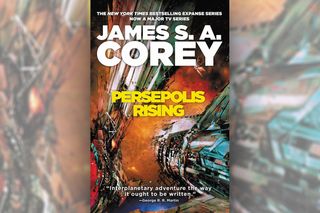'Expanse' Sci-Fi Book Series Nears End with 'Persepolis Rising'

The latest installment in James S.A. Corey's "Expanse" series is the beginning of the end for James Holden's crew, setting a course for the final books of the series.
Corey's "Persepolis Rising" (Orbit, 2017), out today (Dec. 5), is the seventh book in the series. Daniel Abraham and Ty Franck, the two writers who inhabit the pseudonym "Corey," told Space.com last year that the series will ultimately end at nine volumes. (The TV series based on the books, in contrast, is gearing up for a third season and has made it about 1.5 books in, plot-wise.)
The "Expanse" series follows Holden and the crew of his ship, the Rocinante, who seem to be in the middle of every key moment as Earth, Mars and the Asteroid Belt (and, later, a system of colony worlds accessible with alien technology) struggle for control and recognition. The series has built up a rich roster of characters who appear in various roles over time. Villains become heroes; bystanders become leaders, and newbies become seasoned veterans as alliances and conditions shift across the solar system. [Turning a Sci-Fi Series into a TV Epic: Q&A with 'The Expanse' Authors]
"Persepolis Rising" leans hard into that development by jumping ahead three decades after the previous novel's events, the first time the series has made such a drastic time-jump. An older Holden and his crew begin the novel working for the Transit Union that now oversees trade among the many worlds accessible through a system of alien ring gates. But a human state with otherworldly technology emerges to upset the three decades of relative equilibrium.
The premise allows familiar characters to fall back into their earlier roles as they try to defend against the new human threat, but with the added weight of three decades shading their actions and interactions with one another. Watching the Rocinante crew scramble and react is a satisfying part of the new story, as is the slow but continuous drip of hints surrounding the alien protomolecule technology and the forces that might have arrayed against it in the distant past.
Without giving much away, the time skip sets a clear gap between the previous six novels and this one, and this book's ending is a clear act-one finale for the series. Some aspects of the book's main plot are resolved, but enough lines are dangling that you wonder what's about to spring out and grab hold of them.
Email Sarah Lewin at slewin@space.com or follow her @SarahExplains. Follow us @Spacedotcom, Facebook and Google+. Original article on Space.com.
Get the Space.com Newsletter
Breaking space news, the latest updates on rocket launches, skywatching events and more!
Join our Space Forums to keep talking space on the latest missions, night sky and more! And if you have a news tip, correction or comment, let us know at: community@space.com.

Sarah Lewin started writing for Space.com in June of 2015 as a Staff Writer and became Associate Editor in 2019 . Her work has been featured by Scientific American, IEEE Spectrum, Quanta Magazine, Wired, The Scientist, Science Friday and WGBH's Inside NOVA. Sarah has an MA from NYU's Science, Health and Environmental Reporting Program and an AB in mathematics from Brown University. When not writing, reading or thinking about space, Sarah enjoys musical theatre and mathematical papercraft. She is currently Assistant News Editor at Scientific American. You can follow her on Twitter @SarahExplains.
